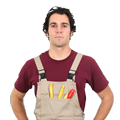Guide to Choosing Curtains and Blinds
So you want to fit new curtains or blinds, and aren't sure what to choose? Both provide privacy, temperature regulation and security as well as adding ambience and managing light in a room. Here are your choices to think about.
Blinds
Exterior Blinds - If your main goal is to keep out light from entering a room, interior blinds may not be enough, and you should consider exterior blinds or awnings. These are versatile options that you can set at different levels depending on the season. Remember that exterior blinds prevent that little bit of light entering a room that you'll get with interior curtains or blinds and this can be exceptionally effective at lowering your cooling costs during summer. A drawback of exterior blinds is that usually you have to go outside to open and close them and sometimes this won't work efficiently, but you can get automated versions you can control from inside.
Roller Blinds - You'll see roller blinds in most Australian homes as they are effective at being very close-fitting and are also cheaper and relatively easy to install. You'll get them in a variety of styles and colours and sizes.
Slatted Blind - These blinds are great design elements and have the benefit of giving a little more privacy while still letting light in (or not letting any in). Slatted blinds can be made of wood or plastic and even reinforced fabric in some cases, and are either horizontal or vertical.
Roman and Austrian Blinds – these types are made from material and collapse or expand as you like, but they are usually thin and block little light out. Also, as they are material they can be difficult to keep clean and will get dusty easily.
Curtains
Fabrics - First think about the primary function when choosing the fabric thickness, type and weight. Thick, heavy lined curtains are best to keep out light and provide insulation. The pattern and colour will depend on the decoration of the room but also darker colours keep out more light and lighter colours let more in. Patterns and prints are increasingly popular over solid colours. Curtains are also flexible so you can have both winter and summer curtains.
Curtain rails + curtain styles - Curtain rails can be hidden or visible depending on whether you want them to be functional or part of the design. Tab top curtains are great to choose if you want to display a beautiful curtain rail, or you can also hide an unattractive curtain rail with a curtains that are hooked. The rail must of course be able to withstand the weight of the curtain and the rails or runners must well attached to the wall to handle the weight of the material (and any exuberant opening and closing!).
Fastening and opening options - You can set up curtains that open and close with the use of drawstrings rather than your hands, which prevents them from becoming dirty over longer periods of time. Drawstrings are also useful for corners and curtains where access is difficult. Decorative tassels and ropes are often used to hold curtains back and can be great design elements. There are also more in-depth options like mechanical opening and closing that you can do by remote control or light sensors.
Curtains and blinds can be purchased and fitted by a competent DIY-er, but there are also specialised companies that will either supply standard ones or design bespoke ones for you - as well as fitting them and usually offering an extensive guarantee. To get quotes from quality curtain and blind businesses, post a job today.


